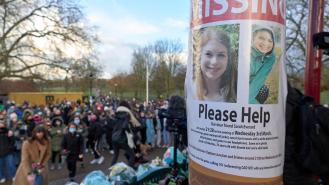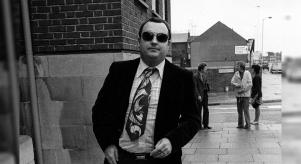


The jealous cop who murdered her ex-boyfriend's new wife
Hosted by Will Mellor, Cops Who Kill lifts the lid on the ultimate betrayal of trust, when police officers become the murderers. Episode four covers the case of Stephanie Lazarus and is available to stream now on Crime+Investigation.
Sherri Rasmussen was a 29-year-old nursing director at the critical care and surgical units at Glendale Adventist Medical Centers. She was happily married to a man named John, and the couple lived in a condominium on Balboa Boulevard in Van Nuys, California.
At around 6pm on 24th February 1986, John had just returned home from work. As soon as he entered the home, he could see that it was in disarray. There was a trail of blood that led into the living room, where he found the lifeless body of his wife. Sherri had been shot several times, and there was evidence of a fierce struggle, including bite marks on her body.
An investigation at the crime scene revealed that Sherri’s silver 1985 BMW was missing from the garage. Investigators immediately put out an all-points bulletin to try and locate the vehicle and announced that John was not considered a suspect.
They theorised that Sherri was attacked after she surprised two burglars in her home. The crime scene made it appear as though she was upstairs when the burglars entered through an unlocked door and began to take a stereo. In the process, they knocked over a glass cabinet, alerting Sherri. When she came downstairs to investigate the source of the noise, she struggled with one of the burglars, who chased her and then shot her.
Sherri’s BMW was discovered near the scene 10 days later, but an examination of the vehicle turned up no evidence. As Detective Lyle Mayer said: ‘It was like it just came from the showroom floor.’ Despite an exhaustive investigation, detectives were not able to identify a suspect. Eventually, the days turned into weeks, the weeks turned into months and the case went cold.
In November 1987, John publicly appealed for information on his wife’s murder. The family also put forward a $10,000 reward for information leading to the arrest and conviction of her killer. The lure of the reward did very little and no lucrative tips came in.
It wasn’t until June 2009 that there was a break in the case. Earlier in the year, detectives in the cold case unit had begun to re-examine the 1986 murder. They sent evidence from the crime scene for further analysis that had become available since advancements in forensic science. This revealed that the DNA from the bite mark to Sherri had come from a woman.
Before Sherri’s murder, John had dated LAPD patrol officer, Stephanie Lazarus. When he became engaged to Sherri, she was distraught, and on one occasion, she and John had slept together without Sherri’s knowledge. He later described this incident as ‘a mistake’.
Sherri’s father, Nels Rasmussen, had always been suspicious of Lazarus. In the lead up to his daughter’s murder, Sherri had confided in him that she was fearful of Lazarus. She told her father that Lazarus had once shown up to her work and warned: ‘If I can’t have John, nobody can.’ On another occasion, Sherri called her father to say that she had found Lazarus standing in her condominium. Then in the days before her murder, Sherri told her father she believed she was being followed by Lazarus.
Lazarus had been working on patrol duty in the San Fernando Valley. She was later promoted to detective, and since 2006, had been working in a unit that tracked stolen art. In the weeks following Sherri’s murder, she reported her personal handgun as stolen. She claimed it had been taken from her car, which was parked near the pier in Santa Monica. Police took the report, but the weapon was never found.
Investigators from the cold case unit began looking into Lazarus as a person of interest upon discovering the killer was a woman. In early June, they followed her as she carried out errands. When she discarded a cup during a shopping trip, they recovered it and then performed DNA testing. It came back as a match to the saliva from the bitemark to Sherri. Lazarus was arrested at police headquarters, where she was working across the hall from the homicide detectives.
On 8th June, Lazarus was charged with the murder of Sherri as well as using a handgun with the special circumstance of murder in commission of a burglary. This allowed prosecutors to seek the death penalty if she were convicted. She subsequently pleaded not guilty and was ordered to be held without bail.
Nels and his wife held a press conference in the wake of the arrest and called on the LAPD to investigate their belief that investigators at the time of Sherri’s murder had overlooked glaring leads that pointed towards Lazarus. He said that he was ‘extremely pleased and relieved’ about the new developments but said that the 1986 investigation ‘is a completely different story’. He revealed that he had urged investigators at the time to look into Lazarus as a suspect but was told: ‘You’ve been watching too much TV.’
In October, Lazarus requested that the case against her be dismissed. Her defence attorney, Mark E. Overland, argued that prosecutors blew their chance of finding the real killer by waiting 23 years to test the bite mark for DNA. He stated: ‘The fact that they waited for DNA matching for 23 years doesn’t wash.’ He also argued that the swab from the bite mark was mishandled by coroner staff.
It was discovered that the envelope containing the evidence was torn in December 2004. The LAPD had called the coroner that month requesting the swab from the bite mark. Initially, staff could not locate the swab and scoured several freezers before discovering it. The employees pulled the envelope out, but it was damaged. According to coroner supervising criminalist Dan Anderson, he put the original envelope in a new envelope but contended he never touched the swab.
The request was denied and a preliminary hearing found that there was enough evidence against her for a trial to proceed. However, Superior Court Judge Robert Perry rejected the special circumstance allegations of lying in wait and murder during the commission of a robbery, which meant that Lazarus was not eligible for the death penalty.
Before the trial proceeded, Sherri’s parents filed a wrongful death lawsuit against the LAPD and Lazarus. In the lawsuit, they claimed that LAPD officials deliberately overlooked evidence that implicated Lazarus in Sherri’s murder. They were later informed that they had waited too long to file the lawsuit and this decision was backed by the California Supreme Court.
The murder trial began on 7th February 2012. During opening statements, Deputy District Attorney Shannon Presby presented a photograph of Sherri in her wedding dress. She said to the jury: ‘Sherri Rasmussen was wearing the gown that Stephanie Lazarus believed was hers.’ They portrayed Lazarus as a jilted lover driven to kill her romantic rival, while the defence portrayed her as an innocent woman who was the victim of mishandled scientific evidence.
During the trial, journal entries from Lazarus were presented by the prosecution. On 4th June 1985, she had written that she ‘found out John was getting married’. She wrote: ‘This is very bad. My concentration is negative-10.’ In the weeks that followed, she requested time off work, writing that she ‘really didn’t feel like working’ and ‘was too stressed out about John’.
A former roommate of Lazarus, former LAPD Sgt. Mike Hargreaves also testified that in the fall of 1985, Lazarus had woken him up and ‘was very upset’. He said that she told him she had been out with John and that he had broken up with her and was marrying Sherri.
LAPD scientist Jennifer Francis told the jury that the DNA taken from the mouth of Lazarus so closely matched the saliva from the bite mark to Sherri’s arm that nobody else could have produced the genetic similarity. This was the prosecution’s key piece of evidence, but Lazarus’ defence team argued that the DNA taken from the bite mark had been corrupted over the years and could not be reliable.
After a three-week trial, the jury was sent off to deliberate. They found Stephanie Lazarus guilty of the first-degree murder of Sherri Rasmussen. The sentencing phase was to follow and John made a poignant victim impact statement. He stated: ‘The fact that Sherri’s death occurred because she met and married me brings me to my knees. I do not know how to cope with this appalling fact.’
Lazarus was subsequently sentenced to 27 years to life in prison.








